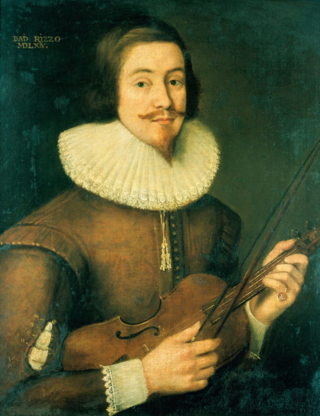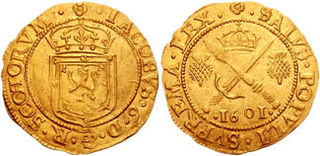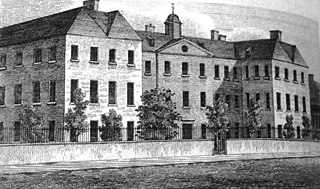
The Demy was a Scottish gold coin struck under reign of James I of Scotland and based on the English half Noble coin. With a face value 9 Scottish shillings the coin was later replaced with the Lion coin by James II of Scotland [1] [2]

The Demy was a Scottish gold coin struck under reign of James I of Scotland and based on the English half Noble coin. With a face value 9 Scottish shillings the coin was later replaced with the Lion coin by James II of Scotland [1] [2]

David Rizzio or Riccio was an Italian courtier, born in Pancalieri close to Turin, a descendant of an ancient and noble family still living in Piedmont, the Riccio Counts di San Paolo e Solbrito, who rose to become the private secretary of Mary, Queen of Scots. Mary's husband, Lord Darnley, is said to have been jealous of their friendship because of rumours that Rizzio had impregnated Mary, and he joined in a conspiracy of Protestant nobles to murder him, led by Patrick Ruthven, 3rd Lord Ruthven. Mary was having dinner with Rizzio and a few ladies-in-waiting when Darnley joined them, accused his wife of adultery and then had a group murder Rizzio, who was hiding behind Mary. Mary was held at gunpoint and Rizzio was stabbed numerous times. His body took 57 dagger wounds. The murder was the catalyst of the downfall of Darnley, and had serious consequences for Mary's subsequent reign.

Earl of Crawford is one of the most ancient extant titles in Great Britain, having been created in the Peerage of Scotland in 1398 for Sir David Lindsay. It is the premier earldom recorded on the Union Roll.

William Lindsay Alexander FRSE LLD was a Scottish church leader.

The pound was the currency of Scotland prior to the 1707 Treaty of Union between the Kingdom of Scotland and the Kingdom of England, which created the Kingdom of Great Britain. It was introduced by David I, in the 12th century, on the Carolingian monetary system of a pound divided into 20 shillings, each of 12 pence. The Scottish currency was later devalued relative to sterling by debasement of its coinage. By the time of James III, one pound Scots was valued at five shillings sterling.
James or Jim Gordon may refer to:

Crawford Castle, substantially in ruins, is located on the north bank of the River Clyde, around 1⁄2 mile north of Crawford, South Lanarkshire, Scotland. The ruins stand on an earlier motte and bailey earthwork. The castle is also known as Lindsay Tower, after its former owners, the Lindsay family. The strategic location of the castle, at NS954213, guards the strategically important Mennock Pass from England into the upper Clyde Valley.

Clan Lindsay is a Scottish clan of the Scottish Lowlands.

Sir Herbert Eustace Maxwell, 7th Baronet, was a Scottish novelist, essayist, artist, antiquarian, horticulturalist, prominent salmon angler and author of books on angling and Conservative politician who sat in the House of Commons from 1880 to 1906.
James Sandilands was a Scottish nobleman. He was the second son of Sir James Sandilands, 7th Baron of Calder. The Barony of Calder had belonged to the Sandilands family since 1348.
Lindsay is both a Scottish surname and a given name. The given name comes from the Scottish surname and clan name, which comes from the toponym Lindsey, which in turn comes from the Old English toponym Lindesege for the city of Lincoln, in which Lind is the original Brittonic form of the name of Lincoln and island refers to Lincoln being an island in the surrounding fenland. Lindum Colonia was the Roman name of the settlement which is now the City of Lincoln in Lincolnshire. Lindum was a Latinized form of a native Brittonic name which has been reconstructed as *Lindon, which means "pool" or "lake" and refers to the Brayford Pool.
Events from the year 1937 in Scotland.
Events from the year 1933 in Scotland.

Thomas Martin Lindsay FRSE (1843–1914) was a Scottish historian, professor and principal of the Free Church College, Glasgow. He wrote chiefly on church history, his major works including Luther and the German Reformation (1900), and A History of the Reformation (1906–1907).

The Glasgow Academy is a coeducational private day school for pupils aged 3–18 in Glasgow, Scotland. In 2016, it had the third-best Higher level exam results in Scotland. Founded in 1845, it is the oldest continuously fully private school in Glasgow.
Events from the year 1799 in Scotland.

The Scottish poorhouse, occasionally referred to as a workhouse, provided accommodation for the destitute and poor in Scotland. The term poorhouse was almost invariably used to describe the institutions in that country, as unlike the regime in their workhouse counterparts in neighbouring England and Wales, residents were not usually required to labour in return for their upkeep.
A Lion was a Scottish gold coin ordered to be struck in 1451 which featured a lion on one side and a depiction of St. Andrew on the other. The coin weighted the same as half an English Noble and was worth six shillings and eight pence.
Anna Lindsay was a Scottish women's activist. She was one of the founders of the Glasgow Association for the Higher Education of Women and her name was said to be synonymous with the women's movement in Scotland. She was the first chairperson of the Scottish Women's Liberal Federation.

John Lindsay, 17th Earl of Crawford, 1st Earl of Lindsay was a Scottish nobleman.
The Wodrow Society, established in Edinburgh in 1841, was a society 'for the publication of the works of the fathers and early writers of the Reformed Church of Scotland'.